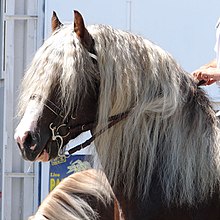This article needs additional citations for verification. (September 2015) |

On horses, the mane is the hair that grows from the top of the neck of a horse or other equine, reaching from the poll to the withers, and includes the forelock or foretop.[1][2]: 247 [3]: 311 It is thicker and coarser than the rest of the horse's coat, and naturally grows to roughly cover the neck. Heredity plays a role, giving some horses a longer, thicker mane, and others a shorter, thinner one.
Some horses, such as those used in circuses or in mounted displays such as Cavalia, have manes allowed to grow down to their knees. Others have their manes deliberately shaved completely off for style or practical purposes. When ungroomed, however, the mane usually grows no longer than the width of the horse's neck, as natural wear and tear limit its potential length.
The mane is thought to keep the neck warm, and possibly to help water run off the neck if the animal cannot obtain shelter from the rain. It also provides some fly protection to the front of the horse, although the tail is usually the first defense against flies.


Horse breeds have tremendous variation in thickness and length. For example, the Appaloosa usually have sparse manes,[2]: 63 whereas Andalusians usually have thick long wavy manes.[3]: 18 [2]: 60 Pony breeds and draft horse breeds tend to have thick manes. Other equids such as the donkey often have very sparse, thin manes. A mane might be the same color as the body hair, or a different color altogether. The Fjord horse has a unique mane coloration of black down the center and silver on the outside edges. Traditional cutting styles were formed to highlight this unique coloration.[4][2]: 81
- ^ Henry, Miles (February 18, 2020). "Why Do Horses Have Manes? It's More Than Just Pretty Hair". horseracingsense.com. Retrieved May 1, 2022.
- ^ a b c d Cite error: The named reference
edwardswas invoked but never defined (see the help page). - ^ a b Cite error: The named reference
belknapwas invoked but never defined (see the help page). - ^ Cite error: The named reference
fjordwas invoked but never defined (see the help page).